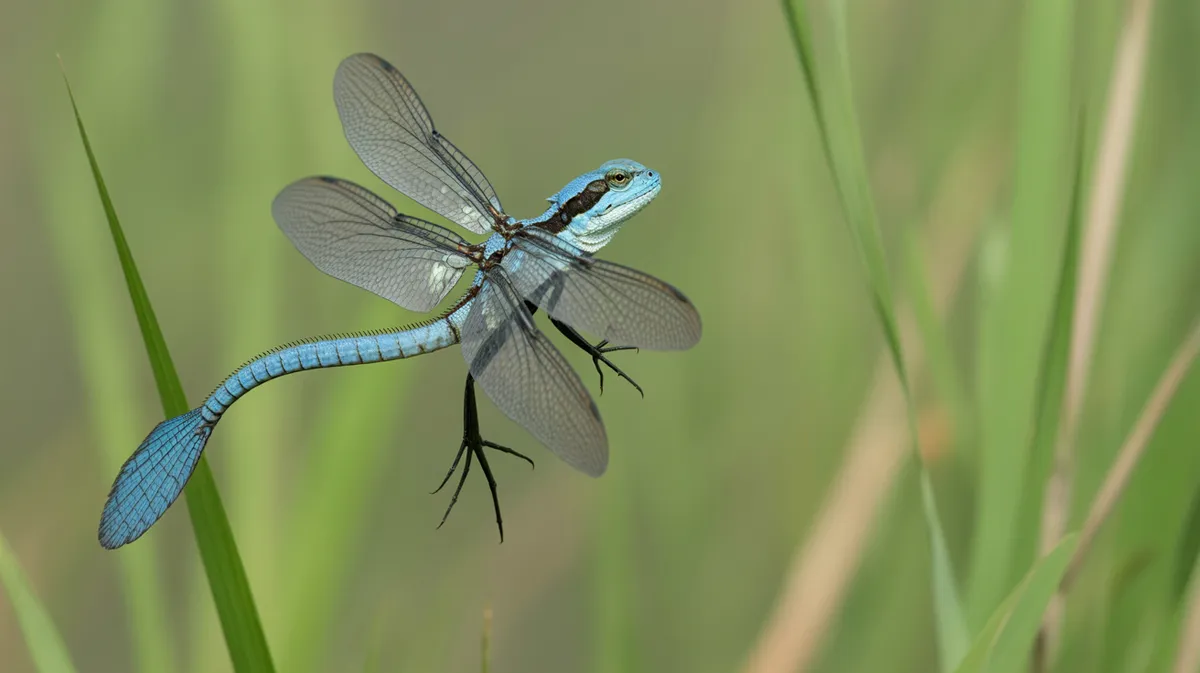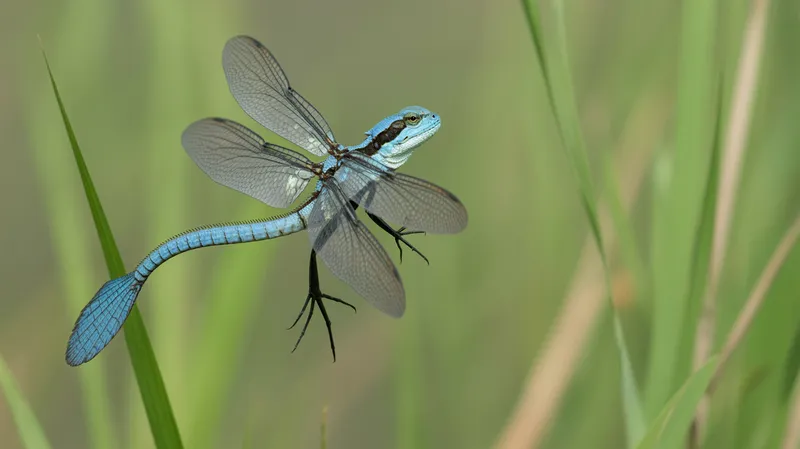
Little Blue Dragon
Diplacodes trivialis

Meet the Little Blue Dragon
The Little Blue Dragon is a small, delicate dragonfly species easily recognized by the bright blue coloration in adult males. Females and immature males are more yellowish or brown, making them less conspicuous. This species is found across South and Southeast Asia, often inhabiting still or slow-moving freshwater bodies such as ponds, marshes, and rice fields. Its agile flight and perching behavior make it a common sight in suitable wetland habitats, where it preys on smaller insects.
Classification
Invertebrate
Habitat
Freshwater wetlands, ponds, marshes, and rice fields
Diet
Carnivore
Lifespan
3-6 months
Conservation
Least Concern
Weight
0.1-0.3 grams
📖Fascinating Facts
Bright Blue Males
Adult males develop a striking powder-blue color on their abdomen and thorax, making them easy to spot near water.
Mosquito Eater
Little Blue Dragons feed on small flying insects, including mosquitoes, helping to control insect populations.
Rice Field Resident
They are frequently found around rice paddies and artificial wetlands, adapting well to human-modified landscapes.
📋Detailed Description
The Little Blue Dragon (Diplacodes trivialis) is a small-sized dragonfly, with adult males typically measuring 25–30 mm in body length and a wingspan of about 40–50 mm. Males are distinguished by their striking powdery blue coloration on the thorax and abdomen, a result of pruinescence, while females and immature individuals display a yellowish-brown to olive hue with black markings. The species possesses large, multifaceted compound eyes that provide nearly 360-degree vision, crucial for detecting prey and predators. Its transparent wings are intricately veined and held horizontally at rest, enabling agile and rapid flight. The Little Blue Dragon is a perching species, often seen resting on low vegetation near water bodies, from which it launches to hunt or patrol territories. It is highly adaptable, thriving in a variety of freshwater habitats, including ephemeral pools, rice paddies, and even urban wetlands. The species is solitary but may be observed in loose aggregations where resources are abundant. Its life cycle includes aquatic larval (nymph) stages that are entirely predatory, contributing to the control of mosquito populations. The adult's lightweight exoskeleton and streamlined body facilitate both aerial agility and efficient thermoregulation, allowing activity during a broad range of daylight hours.
💡 Did you know?
Despite their delicate appearance, Little Blue Dragons are voracious predators, consuming large numbers of mosquitoes and other small insects, making them beneficial for mosquito control.
🔬Research & Sources
🎭Behavior & Social Structure
Diplacodes trivialis exhibits a sit-and-wait predatory strategy, often perching on twigs, grass blades, or emergent vegetation close to water. From these vantage points, it launches short, rapid flights to capture small flying insects such as mosquitoes, midges, and other dipterans. The species is diurnal, most active during warm daylight hours, with peak activity in the morning and late afternoon. Males are territorial, frequently returning to favored perches and engaging in aerial chases to deter rivals. Social interactions are generally limited to mating and territorial disputes, as the species does not form cohesive groups. Adults exhibit basking behavior, orienting their bodies to maximize solar exposure for thermoregulation. They also perform wing-whirring displays, possibly as a deterrent to rivals or as a courtship signal. Larvae are ambush predators, hiding among aquatic vegetation and debris, using their extendable labium to snatch prey.
👶Reproduction & Life Cycle
Breeding occurs throughout the warmer months, often coinciding with the monsoon or rainy season when temporary water bodies are abundant. Males patrol territories near suitable oviposition sites, engaging in brief aerial courtship displays. Copulation is typical of Odonata, involving the formation of a 'wheel' position, with sperm transfer from the male's secondary genitalia to the female. Females lay eggs (oviposition) by dipping the tip of their abdomen into the water, often while still in tandem with the male, to reduce the risk of harassment from other males. Eggs hatch in about 7–10 days, depending on temperature and environmental conditions. The aquatic nymphal stage lasts 2–4 months, during which larvae undergo multiple molts before emerging as adults. There is no parental care after oviposition; survival of eggs and larvae depends on habitat quality and predation pressure.
🛡️Adaptations & Survival
Diplacodes trivialis demonstrates several key adaptations for survival. Its pruinescent blue coloration in males may serve as both camouflage among reflective water surfaces and as a sexual signal. The species' large compound eyes offer exceptional visual acuity for detecting prey and rivals. Its wings are reinforced with nodus and pterostigma, structures that enhance flight stability and maneuverability. The larvae possess a prehensile labium (mask) for rapid prey capture underwater. Adults can regulate body temperature through basking and wing positioning, allowing activity in varying thermal conditions. The species' broad ecological tolerance enables it to exploit a range of freshwater habitats, including disturbed and artificial environments, which contributes to its widespread distribution.
📚Research Sources
🎨Cultural Significance
While the Little Blue Dragon does not have prominent roles in mythology or folklore, dragonflies in general are considered symbols of transformation, agility, and adaptability in many Asian cultures. In rural communities, the presence of dragonflies, including Diplacodes trivialis, is often associated with healthy wetlands and is seen as a natural indicator of good water quality. Their role in controlling mosquito populations is valued in agricultural and peri-urban areas. There are no known traditional uses specific to this species.
🔬Recent Research & Discoveries
Recent research on Diplacodes trivialis has focused on its ecological role in rice agroecosystems, particularly its effectiveness as a biological control agent against mosquito larvae and other pest insects. Studies have also examined its tolerance to pollutants and habitat disturbance, highlighting its potential as a bioindicator species for freshwater ecosystem health. Ongoing research includes genetic studies to clarify phylogenetic relationships within the genus Diplacodes and broader Libellulidae family. Observational studies have documented its rapid colonization of artificial water bodies, underscoring its adaptability and resilience in changing landscapes.
🎥Wildlife Videos

Exciting Animal Behavior in the most enchanting Forests of our Planet | Full Documentary
A forest is like an organism, ancient and full of complex mechanics at work. Its plants need water and a specific range of ...
Free High-Quality Documentaries

Our Planet | Forests | FULL EPISODE | Netflix
Experience our planet's natural beauty and examine how climate change impacts all living creatures in this ambitious ...
Netflix

3 Hours of Incredible 4K Nature Footage | BBC Earth
From the deepest oceans to the highest peaks, here are some of the most beautiful scenes from across the globe. Subscribe: ...
BBC Earth

Australia’s Remarkable Reptiles - Lizards of Oz | Full Documentary
Australia is the driest inhabited continent on the planet with much of the inland being a virtual desert. However, cold blooded ...
Free High-Quality Documentaries

The Big Blue - Ocean Stories from Down Under | Episode 6 | Free Documentary Nature
The Big Blue - Ocean Stories from Down Under | Episode 6: Stewart Island | Ocean Documentary Watch 'The Big Blue - Episode ...
Free Documentary - Nature

#6 Nature's Tiny Marvel!"Meet the Enchanting Blue Dragon Sea Slug! #nature
Nature's Tiny Marvel!"Meet the Enchanting Blue Dragon Sea Slug! #nature #wildliferescue #wildlife " Dive into the mesmerizing ...
PoorMen Earth
🌍Habitat Information
The Little Blue Dragon typically inhabits Freshwater wetlands, ponds, marshes, and rice fields environments. Little Blue Dragons have adapted to their environments with specialized features and behaviors.
Primary Habitat:
Freshwater wetlands, ponds, marshes, and rice fields
More detailed habitat information will be available soon.
🛡️Conservation Status
The Little Blue Dragon is currently classified as Least Concern. Conservation efforts are crucial for preserving this species for future generations.
Common Threats:
- 🏠Habitat loss and fragmentation
- 🌡️Climate change impacts
- 🎯Hunting and poaching
- 🏭Human-wildlife conflict
⚠️Threats & Conservation Challenges
Currently assessed as Least Concern by the IUCN, Diplacodes trivialis faces few significant threats due to its adaptability and broad habitat range. However, local populations may be affected by water pollution, pesticide runoff from agriculture, and loss of wetland habitats due to urbanization and land conversion. Overuse of insecticides in rice fields can reduce larval survival and adult abundance. Climate change, altering rainfall patterns and water availability, could impact breeding sites in the future. Despite these pressures, the species remains common and resilient, with stable population trends across most of its range.
🔬Scientific Classification
Scientific Name
Diplacodes trivialis
Classification Hierarchy
🔍 About Taxonomic Classification
Taxonomic classification is a hierarchical system used by scientists to classify and organize living organisms based on shared characteristics and evolutionary relationships.
The system moves from broad categories (Kingdom) to increasingly specific ones, with each animal's scientific name typically consisting of its Genus and species.
📝Community Notes
Share your observations and insights about the Little Blue Dragon with our community of wildlife enthusiasts.
Join Our Community
Sign in to share your observations and connect with fellow wildlife enthusiasts.
Sign In to ContributeNo community notes yet
Be the first to share your observations about the Little Blue Dragon!
Explore Little Blue Dragon
Select a tab above to learn more about this amazing animal.
📸Photo Gallery
No photos available for this animal yet.
🌟Discover More Wildlife
Continue your journey of discovery with more fascinating animals from our database
